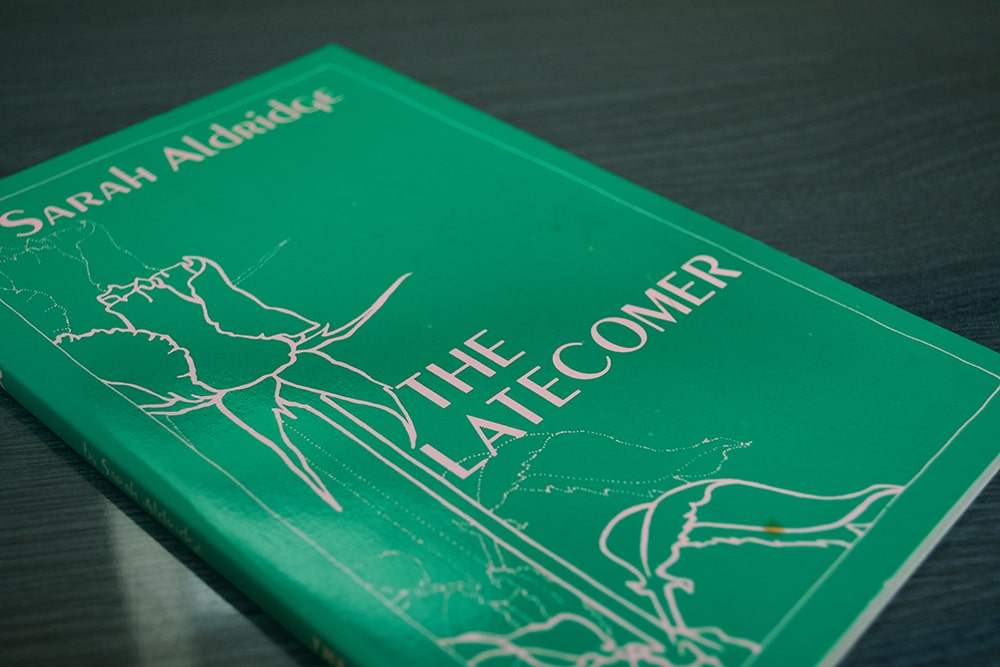Lesbian novels by Sarah Aldridge
Some of the first literary works that captured the experience of lesbians in a more realistic, loving light.
1974-2003,
Sussex County, DE

One of the first lesbian publishing houses, Naiad Press, was co-founded in 1973 by Delaware residents, pioneering lesbian-feminists, and longtime partners, Anyda Marchant (1911-2006) and Muriel Crawford (1914-2006). Marchant wrote and published fourteen lesbian fiction novels using the pseudonym Sarah Aldridge. Her novels broke from stereotypes of lesbian pulp fiction that were often cautionary tales that ended in tragedy. Instead, her literary works focused on strong feminist characters and happy endings.
Anyda Marchant, known by the pen name Sarah Aldridge, offered the queer community a new set of literary works in the mid-twentieth century, allowing lesbians and queer readers to celebrate their identities through the powerful, positive stories she presented as an author and co-publisher.

Marchant, a Brazilian native born as Ann Nelson Yarborough De Armond Marchant who called herself Anyda (pronounced Anita), actually began her career as a lawyer. She first began publishing lesbian-themed short essays as Aldridge in the 1960s in The Ladder, the first lesbian publication created by the Daughters of Bilitis. The pseudonym was chosen as a patchwork of family names, and was used as protection during a time of homophobia and intense discrimination when homosexuals lacked any legal protections and homosexuality was considered an illness.

Marchant grew up in Washington, D.C., where her Brazilian family settled when Marchant was six years old. While pursuing her law degree from George Washington University in the early 1930s (where she also received her undergraduate degree), she served as an assistant to Alice Paul, a women’s rights pioneer who, at the time, was conducting research for the Equal Rights Amendment. After college, Marchant practiced law privately in Virginia and D.C.—where she was one of the first women to pass the bar exam—and then worked cases within the United States Court of Federal Claims and the Supreme Court. In 1940, she was appointed as an assistant in the Law Library of Congress in the Latin American law section. During World War II, her supervisor was drafted and she was promoted to his position. But when he returned, Marchant was asked to step down. She decided to leave the Library of Congress in 1945 in lieu of taking a demotion.
Three years later, Marchant returned to her birthplace Rio de Janeiro, to work briefly as a translator for the Pan-American Union conference in Bogota, Colombia. She would return to America in 1948 and worked in Washington, D.C., where she became one of the first female attorneys for the now-multinational law firm Covington & Burling.
That is when Marchant met her life partner, Muriel Crawford, who worked at Covington & Burling as an executive secretary. They began clandestinely dating, making sure to keep their relationship secret. Crawford was a D.C. native, born in 1914, who would later hold a long-term position as secretary to the president of the Southern Railroad, now known as Amtrak.

Shortly after Thanksgiving 1948, Crawford asked Marchant to move in with her. Marchant agreed, and the two also shared the responsibility of taking care of Crawford’s elderly aunt who also lived in the home. Marchant would go on to briefly work with the U.S. Department of Commerce’s Bureau of Domestic and Foreign Commerce before working for the World Bank, where she stayed for eighteen years until her retirement due to health reasons in 1972.

Meanwhile, the couple—like many other queer people from the D.C. area-began vacationing in Rehoboth Beach, known as the “Nation’s Summer Capital” and located about three hours away from D.C. When they went to purchase their first vacation home in 1957, the local bank refused to lend them the money despite their impressive professional credentials. They ultimately turned to a more progressive bank for the loan. They sold that first home and purchased their second in downtown Rehoboth in 1965. They continued to remain discreet about their relationship.


Marchant and Crawford’s Rehoboth cottage eventually became the site of legendary Saturday evening salons, a historical term for a gathering of intellectuals to exchange ideas and discuss contemporary topics. The gatherings took place on their cottage porch during the summer and at their vacation home in south Florida during the winter, and attracted a diverse crowd of neighbors, clergy, writers, and musicians-gay and straight and of all ages. Fay Jacobs, a contemporary lesbian author who became a close friend of the couple, recalled that Marchant and Crawford loved Dewar’s Scotch whisky and fostered a tradition of toasting a Scotch at sunset.


In 1973, following Marchant’s retirement from the legal field, the couple founded a lesbian publishing house called Naiad Press. The business was named after fantastical figures from Greek mythology known as naiads. Jacobs explained the name, saying: “Naiads were beautiful water nymphs and Naiad Press would allow feminist writer’s words to flow.” It was founded in part as a way for Marchant (as Sarah Aldridge) to publish the lesbian novel, The Latecomer, which she believed would be rejected elsewhere due to the “taboo nature” of homosexuality in the 1970s. In the United States, homosexuality was technically considered a mental disease until 1973. Yet, the couple knew they could foster a broad lesbian audience across the country because of their experiences writing for and reading The Ladder, which ceased production in 1972.

In 1974, The News Journal, Delaware’s main statewide newspaper, reported that Marchant also launched a Sussex County chapter of the National Organization of Women. It is likely that Crawford was also involved in the organization’s creation; however, the women would not publicly identify as partners until they were eventually “pushed out of the closet” in Delaware in 1994. Like many queer people, it would take several years and various avenues for their public “coming out.”
Marchant’s first “coming out” moment was in 1991 at a ribbon cutting ceremony for the new Lambda Rising bookstore in Rehoboth Beach (the original Lambda Rising was founded in 1974 in D.C.). In 1994, she appeared at Lamba Rising again for a book signing of her novel, Michaela.
hat same year, Marchant was interviewed by The News Journal’s Gary Soulsman for an article called “The coming out of Anyda Marchant,” which was celebratory in tone and introduced the general population of Delaware to a pioneering lesbian-feminist author. While Marchant had been interviewed before about her lesbian novels, none of those interviews were in Delaware papers or really reached the larger Delaware community. It wasn’t until The News Journal learned of a writing award Marchant had been given at a Mid-West women’s music festival that she was asked for an interview focusing on her queer identity.

Marchant told Jacobs that she realized doing the interview would mean coming out to her Delaware community, which she believed would behoove her status as a novelist. In the article, Marchant described her feelings about her sexuality, saying, “I’ve never been uncomfortable with myself. What I’ve been uncomfortable with is being in a society where I don’t seem to fit in.” But Crawford said she would have preferred to stay quiet; regardless, she told Marchant to do the interview. Crawford told Jacobs: “Then on the day after the newspaper article came out, I just slunk into church, very afraid.”
Despite her fear, Jacobs wrote that the couple was “greeted with wide open arms and congratulations.” Marchant said she didn’t feel any different, but Crawford said being in the open after 80 years of being in the closet did feel different when they were out in public. Yet, with their coming out, more new people began attending the Saturday evening salons, providing them an opportunity to connect with younger queer people.

When first launching Naiad press and her writing career as Aldridge, Marchant and Crawford relied on the help of The Ladder’s mailing list, which was held by the magazine’s final editor and one of Naiad Press’s business partners, Barbara Grier, Marchant and Crawford were able to promote Naiad Press among an existing queer audience. With a $2,000 investment from Crawford and Marchant, Naiad Press was officially launched on January 1, 1973.

At first, the couple struggled to find a printer willing to produce lesbian-centric books. Editorial decisions were made in Kansas City by the couple’s business partners, Grier and Donna McBride, while the physical books were shipped by the queer-friendly printers to Marchant and Crawford’s Rehoboth home where they distributed the books from their garage. Initially, Marchant, Crawford, Grier, and McBride sought volunteers to hand-deliver books to avoid suspicion of distributing what was considered at the time to be pornographic and inappropriate, Marchant told writer Andrea Peterson in an interview. The team of women took advantage of the large network of independently owned queer bookstores, newspapers, and journals to get the word out about Naiad Press.
The Latecomer, which was the first Aldridge novel and is known as one of-if not the first-lesbian novels with a happy ending, was the first book published by Naiad Press. The story is named after its lead character, a heroine who “comes late to a realization of who and what she is.” The story is told without ever using the word lesbian (later Aldridge novels do use the term). Marchant wanted her novel to describe a woman’s sexual and emotional awakening, but not in a traumatic way like the early lesbian fiction novel, The Well of Loneliness (1928). Historically, lesbian pulp fiction only included protagonists who were punished in the end-often by being murdered or committing suicide. The Latecomer defied that conventional storyline by ending with the promise of a happy future for the two main characters. The book would be republished on its thirty-fifth anniversary, as a celebration of the legacy of the work’s impact on the queer community.

In 1994, Marchant told The News Journal: “For women from my generation, thinking about your sexual identity was like picking up a stone and seeing what was underneath. It was scary.” She elaborated on her writing style, saying, “I don’t like clinical descriptions of sex. The most erotic writing heightens sensation through implications rather than detail.”

Marchant, as Aldridge, published fourteen novels, all of which focused more on the female characters’ feelings rather than the physical details of interactions, leaving much to the imagination. Her novels portrayed healthy lesbian relationships and women who built intense feelings for each other. Other works include the 1989 novel, Keep to Me, Stranger, set in Washington, D.C. in the 1950s during McCarthyism and the Lavender Scare era. The 1992 novel, A Flight of Angels, is about two middle-aged lesbians dealing with the death of one woman’s husband who died of AIDS. The 1997 novel, Nina in the Wilderness, follows the experience of seventeen-year-old Nina, the sole survivor of a plane crash, as she falls in love with her friend, Annie. She hand-wrote her last novel, O Mistress Mine, at age 92. Crawford typed up the manuscript.


In addition to the Aldridge novels, Naiad Press also published romances, mysteries, and works by other women authors. Crawford took pride in publishing the work of lesbian writers who may have otherwise not been published because of homophobia and fear of retribution. Marchant and Crawford never achieved (or expected to achieve) great financial success with this publishing company, but they used money from the sales of Marchant’s books to finance her future work. In 1995, Grier and McBride bought full control of Naiad. Marchant and Crawford retained the existing inventory of books and all rights to the Aldridge novels.
Marchant and Crawford then founded their own publishing house called A&M Books (A&M standing for Anyda and Muriel) in 1995. This new venture’s first book to publish was Jacobs’s As I Lay Frying: A Rehoboth Beach Memoir in 2004, followed by Celebrating Hotchclaw by Ann Allen Shockley, a journalist and author who wrote the first novel published about Black lesbians (Loving Her, 1974) and former librarian at Delaware State College (now Delaware State University). Between the age of 83 and 92, Marchant wrote her final three Aldridge novels, all of which were published by A&M.

Jacobs, who owns many of the couple’s original and signed Aldridge novels and Naiad Press materials, said of the works’ legacy:
Beginning with The Latecomer in 1974 and ending 14 books later with O, Mistress Mine in 2003, these romance novels are rich in historical detail. They celebrate American and European locales and make a case for lesbian equality, subtly in the early titles and more fervently toward the end of the series. They feature lesbian doctors, attorneys, professors and other independent women.
In January 2006, Marchant passed away at age 94. Crawford followed her just months later, passing away in June 2006 at the age of 93
The couple left A&M publishing to Jacobs, and the publishing house lived on until 2014. In light of the loss of this important literary couple and her friends, Jacobs told The News Journal:
Their lives parallel the growth of acceptance of gay and lesbian community. If Anyda’s books weren’t out there, women wouldn’t have known that there was a happy, fulfilling life available to them. … I get letters from women in isolated communities saying, ‘The Sarah Aldridge books saved our lives.’ That’s the legacy I hope to keep alive.
Photo Courtesy: Fay Jacob, The News Journal, CAMP Rehoboth Research Library, Carolanne Deal
Sources:
- Faderman, Lillian, Odd Girls and Twilight Lovers: A History of Lesbian Life in 20th century America (New York City: Columbia University Press, 1991).
- Jacobs, Fay, Fried & True: Tales from Rehoboth Beach (Rehoboth Beach: A&M Books, 2007)
- Jacobs, Fay, “Marchant, Anyda [Sarah Aldridge] and Muriel Inez Crawford (1914-2006),” glbtq, Inc., 2015.
- Johnson, Lynn, “A Legacy of Love and Literature,” The News Journal, September 13, 2006
- Kuda, Marie J., “Naiad Press Founder Dies.” Windy City Times, February 1, 2006
- Peterson, Andrea L.T., “‘The Latecomer’ by Sarah Aldridge,” Lambda Literary, January 21, 2010
- Soulsman, Gary, “The coming out of Anyda Marchant,” The News Journal, June 16, 1994
- “We Remember,” Letters From Camp Rehoboth, February 10, 2006
Explore Other Authors
-

My Rainbow and Trinity Neal’s “Rainbow” Wig
Wilmington, DE
Items of significance to Wilmington resident Trinity Neal’s experience as a transgender girl.


